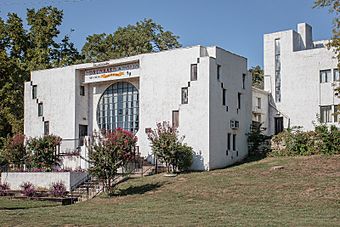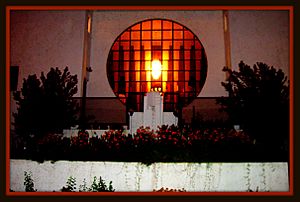Riverside Studio facts for kids
Quick facts for kids |
|
|
Riverside Studio
|
|
 |
|
| Location | 1381 Riverside Dr., Tulsa, Oklahoma |
|---|---|
| Built | 1928 |
| Architect | Goff, Bruce |
| Architectural style | International Style |
| MPS | Bruce Goff Designed Resources in Oklahoma MPS |
| NRHP reference No. | 01000656 |
| Added to NRHP | June 14, 2001 |
The Riverside Studio is a special building in Tulsa, Oklahoma, United States. It was built in 1928 and is also known as the Tulsa Spotlight Theater. A famous architect named Bruce Goff designed it in a modern style called International Style.
The building was first made as a home with a music studio for a teacher named Patti Adams Shriner. Because of its unique design, the Riverside Studio was added to the U.S. National Register of Historic Places in 2001. This means it is an important historical place.
Contents
History of Riverside Studio
From Music to Theater
The Riverside Studio had many cool and artistic features. It had a big, round window at the front. There was also a fountain designed by an Italian artist named Alfonso Iannelli. Inside, you could find fireplaces made of black glass and green marble. The walls had special Japanese coverings made from wood. There were even nine murals painted by an Oklahoma artist, Olinka Hrdy.
In 1933, Ms. Shriner lost the building. It was empty for a while. Then, in 1941, an actor named Richard Mansfield Dickinson bought it. He paid $2,500 for the building.
The Spotlight Club and The Drunkard
Since 1953, Richard Mansfield Dickinson's group, the Tulsa Spotlight Club, has used the building. They put on a play called The Drunkard. This play is a very old story from the 1800s about someone who drinks too much and learns a lesson.
In 2008, Charles Conrad, who was in charge of the Spotlighters, wanted to fix up the building. He hoped to make it look like it did when it was first built. He also wanted to update the electricity and heating. However, this work would cost a lot of money, about $700,000. This was too much for the club to pay.
By 2012, the club had fixed the roof, updated the bathrooms, and turned an upstairs bedroom into a library. In 2013, a new director, Joe Sears, took over the play. Joe Sears is well-known for creating the Greater Tuna plays. The play The Drunkard has been performed almost every Saturday night for over 70 years! The club says it is the longest-running play in America.
Building Design Details
The Riverside Studio is a two-story building. It is built into a hillside and faces west toward the Arkansas River. The building has a flat roof and its outside walls are covered in stucco.
The entrance hall, which has two stories, is a very important part of the building's design. Two sets of outdoor stairs lead to a landing. From there, you can enter the foyer. The large, flat, circular window at the front of the foyer is a main decoration. Other windows on the front are stepped. They have black glass parts that create a diagonal pattern.
Behind the foyer is an auditorium, which is like a recital hall. Here, the audience would sit facing east toward the stage. The auditorium is one story tall. It has three sets of double doors on both its north and south sides. The auditorium connects the entrance hall to the living areas. Its shape creates partially enclosed patio areas on both sides of the building. The stage is in the wing east of the auditorium. There is a small service area and kitchen at the north end of the stage. A living room, garage, and servant quarters are at the south end. This part of the building is two stories high, with a small section that is three stories.
Changes Over Time
The original living room walls were covered with special wood from Japan. The ceiling had aluminum leaf decorations. The room also had a fireplace with green marble and black glass. Also, there were four murals by Olinka Hrdy in the recital hall.
Over the years, some of these original features changed. The Iannelli-designed fountain was taken apart. Air-conditioning ducts were added later, blocking some side doors of the recital hall. Even with these changes, the building is still considered very important for its history and design.
See also
- Olio (musical number)
- The Drunkard




